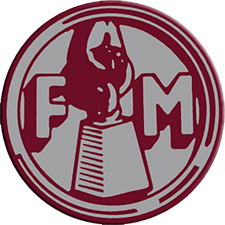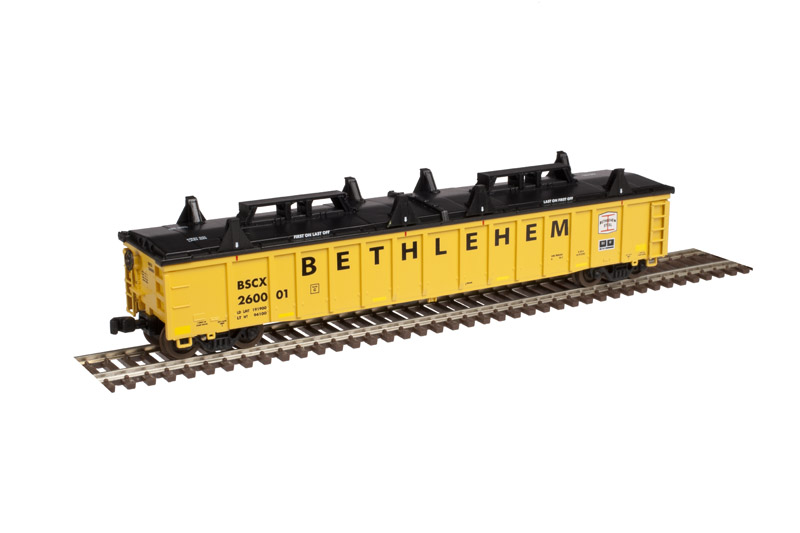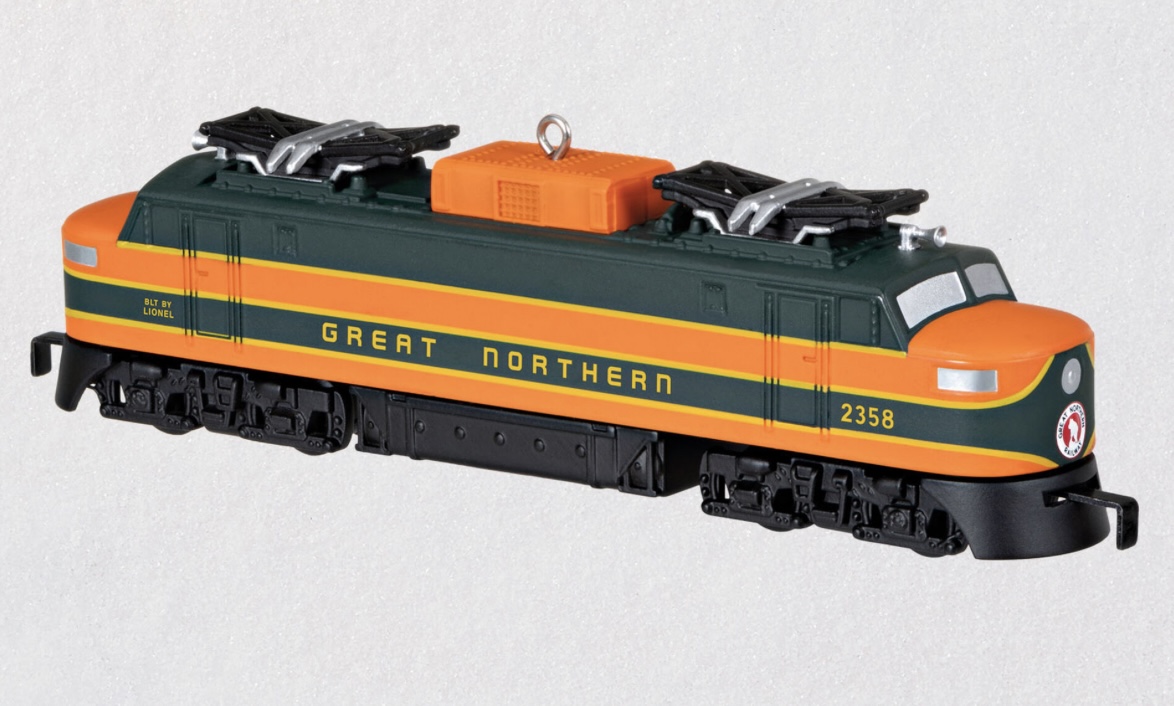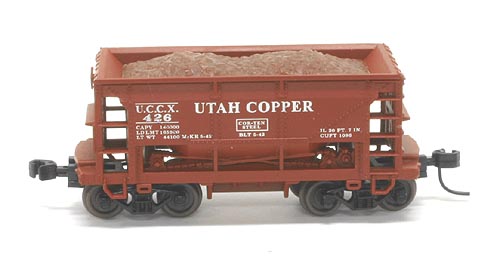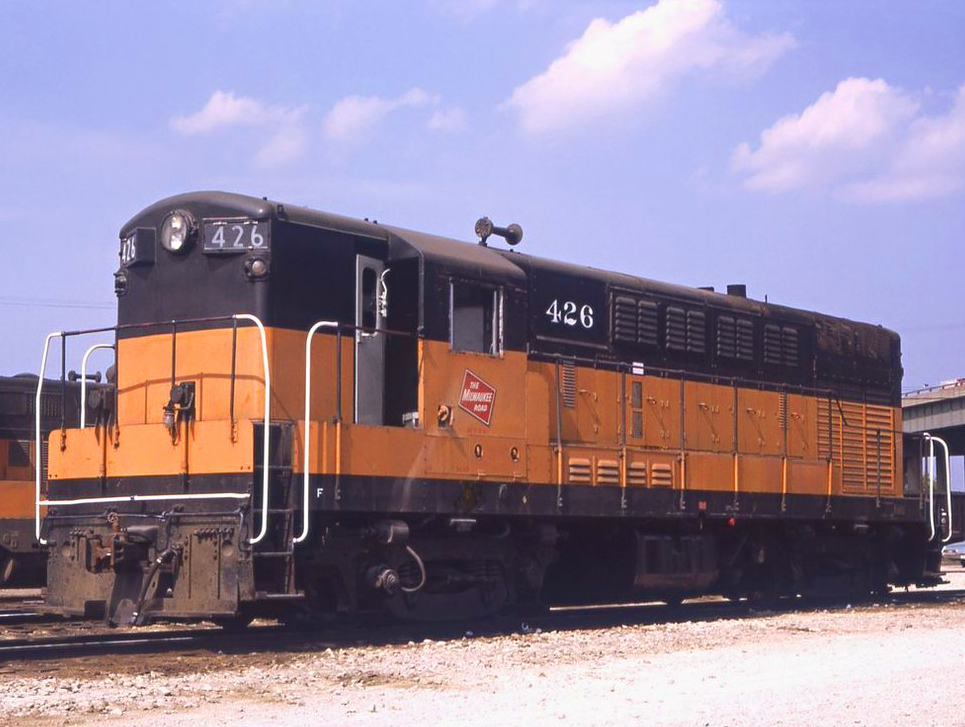Model Information: Atlas introduced the Fairbanks-Morse H-15-44 and H-16-44 models in 2003. These two body styles share the same internal mechanism. The models are standard high-quality modern mechanisms featuring split-frames, dual flywheels, and magnetic operating knuckle couplers.
They have typical high-end smooth and quiet running and can pull the expected 30+ cars on a flat surface.
These models are delivered in several variations:
- Early or Late body
- Rounded or Square windows
- Sill- or Body-mounted handrails
These models are delivered in several variations:
- Early or Late body
- Rounded or Square windows
- Sill- or Body-mounted handrails
DCC Information: These models are DCC-Friendly and accept drop-in decoders such as the Digitrax DN163A0.
The DCC install requires some work, because of the reversible green/red classification lights, that will not come with the above replacement drop-in decoder. For this reason, these models are decidedly DCC-Friendly rather than DCC-Ready. In our opinion, it is worth the extra $ to buy a decoder-equipped version (with a NCE decoder) rather than do it yourself unless you are very comfortable with a soldering iron. Brad Myers has an excellent guide (NScaleStations Blog) on how to do it if you are feeling brave.
The DCC install requires some work, because of the reversible green/red classification lights, that will not come with the above replacement drop-in decoder. For this reason, these models are decidedly DCC-Friendly rather than DCC-Ready. In our opinion, it is worth the extra $ to buy a decoder-equipped version (with a NCE decoder) rather than do it yourself unless you are very comfortable with a soldering iron. Brad Myers has an excellent guide (NScaleStations Blog) on how to do it if you are feeling brave.
Prototype History: The FM H-16-44 was a road switcher produced by Fairbanks-Morse from April 1950 – February 1963. The locomotive shared an identical platform and carbody with the predecessor Model FM H-15-44 (but not the FM H-20-44 end cab road switcher which used a different carbody and frame and a larger prime mover), and were equipped with the same eight-cylinder opposed piston engine that had been uprated to 1,600 horsepower (1,200 kW). The H-16-44 was configured in a B-B wheel arrangement, mounted atop a pair of two-axle AAR Type-B road trucks with all axles powered. In late 1950, the AAR trucks were almost exclusively replaced with the same units found on the company's "C-liner" locomotives.
The FM H-16-44 would prove the builder's most successful road-switcher of the five Fairbanks-Morse ultimately cataloged. Not only did this particularly locomotive see strong sales but the company also found a variety of buyers including foreign lines in Mexico as well as orders through its subsidiary, the Canadian Locomotive Company. 209 were built for American railroads, 58 were manufactured from March 1955 – June 1957 by the Canadian Locomotive Company for use in Canada, and 32 units were exported to Mexico.
From Wikipedia
Read more on American-Rails.com
Full F-M H-16-44 data sheet on The Diesel Shop.
The FM H-16-44 would prove the builder's most successful road-switcher of the five Fairbanks-Morse ultimately cataloged. Not only did this particularly locomotive see strong sales but the company also found a variety of buyers including foreign lines in Mexico as well as orders through its subsidiary, the Canadian Locomotive Company. 209 were built for American railroads, 58 were manufactured from March 1955 – June 1957 by the Canadian Locomotive Company for use in Canada, and 32 units were exported to Mexico.
From Wikipedia
Read more on American-Rails.com
Full F-M H-16-44 data sheet on The Diesel Shop.
Road Name History: The Baltimore and Ohio Railroad (reporting marks B&O, BO) is one of the oldest railroads in the United States and the first common carrier railroad. It came into being mostly because the city of Baltimore wanted to compete with the newly constructed Erie Canal (which served New York City) and another canal being proposed by Pennsylvania, which would have connected Philadelphia and Pittsburgh. At first this railroad was located entirely in the state of Maryland with an original line from the port of Baltimore west to Sandy Hook. At this point to continue westward, it had to cross into Virginia (now West Virginia) over the Potomac River, adjacent to the confluence of the Potomac and Shenandoah rivers. From there it passed through Virginia from Harpers Ferry to a point just west of the junction of Patterson Creek and the North Branch Potomac River where it crossed back into Maryland to reach Cumberland. From there it was extended to the Ohio River at Wheeling and a few years later also to Parkersburg, West Virginia.
It is now part of the CSX Transportation (CSX) network, and includes the oldest operational railroad bridge in the USA. The B&O also included the Leiper Railroad, the first permanent horse-drawn railroad in the U.S. In later years, B&O advertising carried the motto: "Linking 13 Great States with the Nation." Part of the B&O Railroad's immortality has come from being one of the four featured railroads on the U.S. version of the board game Monopoly, but it is the only railroad on the board which did not serve Atlantic City, New Jersey, directly.
When CSX established the B&O Railroad Museum as a separate entity from the corporation, some of the former B&O Mount Clare Shops in Baltimore, including the Mt. Clare roundhouse, were donated to the museum while the rest of the property was sold. The B&O Warehouse at the Camden Yards rail junction in Baltimore now dominates the view over the right-field wall at the Baltimore Orioles' current home, Oriole Park at Camden Yards.
At the end of 1970 B&O operated 5552 miles of road and 10449 miles of track, not including the Staten Island Rapid Transit (SIRT) or the Reading and its subsidiaries.
Read more on Wikipedia.
It is now part of the CSX Transportation (CSX) network, and includes the oldest operational railroad bridge in the USA. The B&O also included the Leiper Railroad, the first permanent horse-drawn railroad in the U.S. In later years, B&O advertising carried the motto: "Linking 13 Great States with the Nation." Part of the B&O Railroad's immortality has come from being one of the four featured railroads on the U.S. version of the board game Monopoly, but it is the only railroad on the board which did not serve Atlantic City, New Jersey, directly.
When CSX established the B&O Railroad Museum as a separate entity from the corporation, some of the former B&O Mount Clare Shops in Baltimore, including the Mt. Clare roundhouse, were donated to the museum while the rest of the property was sold. The B&O Warehouse at the Camden Yards rail junction in Baltimore now dominates the view over the right-field wall at the Baltimore Orioles' current home, Oriole Park at Camden Yards.
At the end of 1970 B&O operated 5552 miles of road and 10449 miles of track, not including the Staten Island Rapid Transit (SIRT) or the Reading and its subsidiaries.
Read more on Wikipedia.
Brand/Importer Information: In 1924 Stephan Schaffan, Sr. founded the Atlas Tool Company in Newark, New Jersey. In 1933 his son, Stephan Schaffan, Jr., came to work for his father at the age of sixteen. Steve Jr. built model airplanes as a hobby and frequented a local hobby shop. Being an enterprising young man, he would often ask the owner if there was anything he could do to earn some extra spending money. Tired of listening to his requests, the hobby-store owner threw some model railroad track parts his way and said, "Here, see if you can improve on this".
In those days, railroad modelers had to assemble and build everything from scratch. Steve Jr. created a "switch kit" which sold so well, that the entire family worked on them in the basement at night, while doing business as usual in the machine shop during the day.
Subsequently, Steve Jr. engineered the stapling of rail to fiber track, along with inventing the first practical rail joiner and pre-assembled turnouts and flexible track. All of these products, and more, helped to popularize model railroading and assisted in the creation of a mass-market hobby. The budding entrepreneur quickly outgrew the limitations of a basement and small garage operation. Realizing they could actually make a living selling track and related products, Steve and his father had the first factory built in Hillside, New Jersey at 413 Florence Avenue in 1947. On September 30, 1949, the Atlas Tool Company was officially incorporated as a New Jersey company.
In 1985, Steve was honored posthumously for his inventions by the Model Railroad Industry Association and was inducted into the Model Railroad Industry Hall of Fame in Baltimore, Maryland. In addition, Steve was nominated and entered into the National Model Railroad Association Pioneers of Model Railroading in 1995.
In the early 1990s, the Atlas Tool Company changed its name to Atlas Model Railroad Company, Inc.
In those days, railroad modelers had to assemble and build everything from scratch. Steve Jr. created a "switch kit" which sold so well, that the entire family worked on them in the basement at night, while doing business as usual in the machine shop during the day.
Subsequently, Steve Jr. engineered the stapling of rail to fiber track, along with inventing the first practical rail joiner and pre-assembled turnouts and flexible track. All of these products, and more, helped to popularize model railroading and assisted in the creation of a mass-market hobby. The budding entrepreneur quickly outgrew the limitations of a basement and small garage operation. Realizing they could actually make a living selling track and related products, Steve and his father had the first factory built in Hillside, New Jersey at 413 Florence Avenue in 1947. On September 30, 1949, the Atlas Tool Company was officially incorporated as a New Jersey company.
In 1985, Steve was honored posthumously for his inventions by the Model Railroad Industry Association and was inducted into the Model Railroad Industry Hall of Fame in Baltimore, Maryland. In addition, Steve was nominated and entered into the National Model Railroad Association Pioneers of Model Railroading in 1995.
In the early 1990s, the Atlas Tool Company changed its name to Atlas Model Railroad Company, Inc.
Item created by: Steve German on 2016-04-25 00:32:30. Last edited by Alain LM on 2021-01-01 13:40:44
If you see errors or missing data in this entry, please feel free to log in and edit it. Anyone with a Gmail account can log in instantly.
If you see errors or missing data in this entry, please feel free to log in and edit it. Anyone with a Gmail account can log in instantly.





